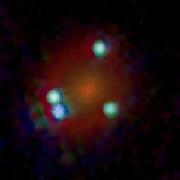Gravitational Lensing
The phenomenon at the root of gravitational lensing is the deflection of light by gravitational fields predicted by Einstein's general relativity, in the weak-field limit. The deflection has well-known observable effects, such as multiple images, magnification of images, and time delays for propagation of light along the paths forming different images. Because the effect is independent of wavelength, multiple lensed images share a single spectrum, which helps us to identify lensed images.
We currently distinguish three regimes: strong (or macro) lensing, weak lensing and microlensing. In strong lensing, the light from a distant source such as a quasar or galaxy is deflected by an intervening galaxy or cluster of galaxies, forming multiple images of the source. In weak lensing, the light from a distant source is distorted but not multiply imaged. The strength and spatial distribution of the effect are determined by measuring many distorted images and deriving a statistical measure of the lensing. In microlensing, the light from a distant source is already macro-lensed, but components such as stars in the lens add their own deflections. The effect appears as additional, measurable magnification.
A few examples of the application of gravitational lenses are: estimates of the amount of dark matter in galaxies and clusters of galaxies, measurements of the evolution of galaxies with cosmic time, the age of the universe and estimates of constraints on dark energy. Because the physics of gravitational lensing is well-established, these estimates are robust and provide unique constraints, complementary to those from other astrophysical techniques.
Emilio Falco, Brian McLeod




